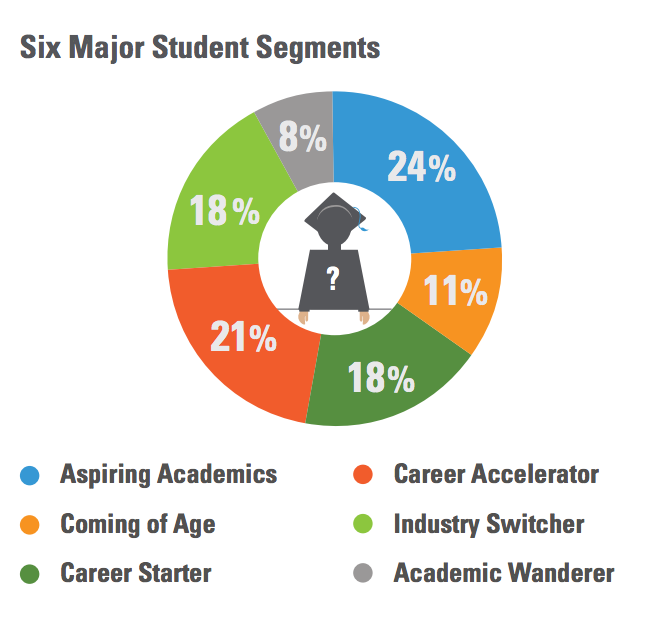
Student segmentation and predictive modeling are becoming mainstream discussion topics for university administrators. How do you reach, recruit and serve different student segments?
We have once again been reflecting on a report distributed by the Parthenon Group a few years ago that we still find relevant today. Isn't it amazing how strong content can remain relevant over time? This particular study on audience segmentation was called: The Differentiated University. Let's take a look and see what new insights you (and all of us) can take away from this research.
Let's remember that this data is now a few years old... but do these trends sound familiar to you? They should. Many are still true today.
Elevator summary:
- The number of traditional students (4-year college path while 18-22 yrs old) is declining due to demographic, economic and other societal pressures
- Parthenon Group created six student categories with different aspirations, needs, time frames and education objectives
- Most universities and colleges are focusing an outsized portion of their marketing budget on reaching less than one quarter of the education seeking market
- To survive, and thrive, universities need to look beyond the traditional student enrollment for a 2-and 4-year post-high school period
- Life-long learning services need to become a program market segment for all academic institutions
- Universities need to develop marketing approaches, processes, and capabilities to reach a range of desirable student groups throughout the education cycle which extends far beyond 22-year-olds and will likely include a range of education programs that vary greatly from the traditional 4 year format.

Source: Parthenon Group.
The six segments listed above are describing different mindsets, needs, and age brackets for students looking to enhance their education. Only the Aspiring Academics and Coming of Age segments are really following the traditional education path post high school.
We picked one of the segments for further exploration and we would like you to think beyond the segmentation research. The actual student segmentation is valuable from our perspective since it allows a university or college to focus on potential, specific student audiences. The thinking follows the traditional development of a market segmentation and the corresponding attributes of the buyer profile.
Consider the motivations of each student segment and how you can serve their needs best.
As Parthenon and one of the authors, Jeff Selingo, have pointed out elsewhere, universities typically center their marketing and operations around the Aspiring Academics segment which is only about 1/5 of the total student population looking for education opportunities today.
Right there, that's significant. If you are wondering whether this is true for your institution, just look at your marketing budget. How much of it is being spent on marketing staff and activities specifically focused on this 20% slice of the market?
Once you know your different target student groups, universities and colleges will have to tailor their services and reach the appropriate consumers. That's where the hard work is going to be. Academic calendars, teaching and support staff, teaching schedules, facilities are centered around the traditional student schedule. The long-term viability of most institutions will depend on tailoring services and attracting distinct, alternative student segments. And some of these alternative segments have stronger buying power along with their different needs and motivations.
The Career Accelerator, estimated to account for 21% of the total student pool – almost the same size as the traditional Aspiring Academics – is one of the most interesting segments. This student segment is already being offered many substitutes to the traditional college experience. This motivated student group requires flexibility. They tend to be older and in the midst of their careers.
As the authors point out, competency-based credit models may fit their needs and hybrid or online providers will offer interesting alternatives for this group. Their need for the social experience is limited and flexible support for spouses and children will go a long way as enticements for student recruiting. How much of your operating budget will go into those ancillary services? And what will the return on investment be if you make that investment? It could be quite a bit higher than the ROI on your last direct mail piece targeting Aspiring Academics. Something to think about.
These marketing calculations and long-term plans are important today as many institutions are being threatened with their very survival. A New York Times story quoted Harvard Business Professor Clay Christensen, author of "The Innovator's Dilemma." Professor Chistensen predicts that 50% of US higher education institutions could face bankruptcy by 2029 (NYT story link). A bold and dire prediction to be sure.
But what if he's even just half right? Enrollment marketers need to think beyond the creative design of the next ad campaign and how their social media can take it up a notch. It's time to dive deep into the data and develop a long-term marketing plan that reaches specific market segments for whom your services are highly relevant. That level of effort involves product development along with strategic marketing, predictive modeling and analytics.
This is no time to sit back and simply rely on your graphic design team. We know they are good, but you're probably going to need some help. Do you know any experts in the field?... We do.

This blog post was originally published in 2014, but has since been updated and revised to include new links and additional content.

